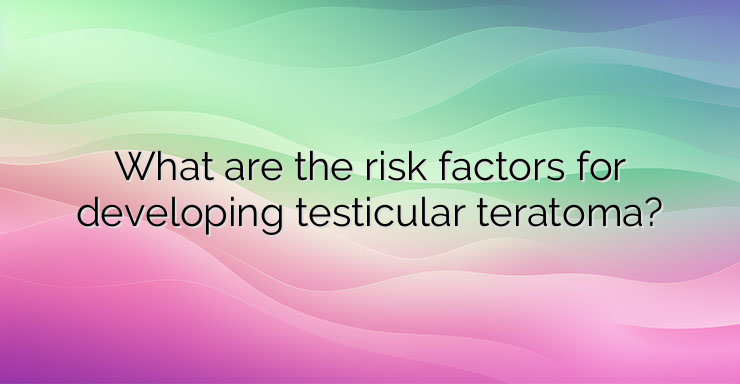What is testicular teratoma? A testicular teratoma is a neoplasm (cancer) arising from the germ cells of the testicle. A germ cell is any cell that gives rise to gametes (sex cells). Teratomas are usually made up of different tissues originating from the three germ layers. The testicles are the male gonads in which spermatozoa (spermatogenesis) and the sex hormone testosterone are formed. The testes are located in the scrotum, but actually develop on the posterior surface of the abdominal cavity before migrating to their position in the scrotum, through the inguinal canal, during the 7th month of embryological development. Testicular defect (cryptorchidism) is a common condition in newborn boys, occurring in 30% of premature babies and 5% of full-term babies. Cryptorchidism is a risk factor for testicular cancer. What is the incidence of testicular teratoma? Testicular cancer is a rare condition, accounting for less than 1% of all malignancies in men, but has a higher incidence in younger men. Testicular teratoma accounts for 40% of testicular cancers and is most common between the ages of 20 and 30, but can occur at any age from infancy to adulthood. Testicular cancer occurs worldwide, but with the highest incidence in developed countries. The lowest incidence of the disease is in African and Asian countries, while its highest incidence is in Scandinavian countries. There are two types of testicular teratomas: A prepubertal teratoma is considered an indolent (benign) tumor and is not associated with germ cell neoplasia in situ (confined to its original location), with the testis showing normal spermatogenesis and no metastatic potential. This histotype is not specific to children and can also be found in adult patients. This group includes dermoid or epidermoid cysts; Postpubertal teratoma arises from germ cells in situ and has metastatic potential (metastasizes in 22% to 37% of cases) Outcomes in patients with localized disease are good and they can be operated on. Patients with metastases have a worse prognosis, which depends on several clinical and pathological factors, and are treated by a multimodal approach involving a team of different specialists. Metastatic tumors do not respond well to chemotherapy, and the goal is to achieve complete surgical resection. What are the risk factors for testicular teratoma? Risk factors for testicular teratoma include: Cryptorchidism – almost 10% of testicular tumors are found in patients with cryptorchidism (failed descent of the testes into the scrotum); Genetic predisposition – specific genes have been identified,which play a role in the occurrence of testicular teratoma; Previous testicular cancer; Family history (case in family) of testicular cancer; HIV infection; Abnormalities in testicular development; Exposure to estrogens (female sex hormones) in the womb; Possible testicular torsion (twisting of the spermatic cord that disrupts blood supply to the testicles), mumps orchitis, testicular trauma, and occupational exposure to chemicals Testicular teratoma spreads by hematogenous (blood) and lymphatic routes. Hematogenous spread (metastasis) to the lungs, liver, bones, and brain occurs relatively early in the course of the disease, so that many patients may already have advanced disease when the cancer is discovered. Testicular teratoma tends to spread to the lymph nodes near the aorta. Painless enlargement of one testicle is a characteristic symptom of the disease. References: 1. Adkins L. Teratomas and Other Germ Cell Tumours. Emedicine 2. Light D. Testicle, Malignant Tumours. Emedicine 3. Hoenig D, Rechtschaffen T. Testicular Tumours: Nonseminomatous. Emedicine 4. National Center for Biotechnology Information (NCBI). Testicular Teratoma


Leave a Reply